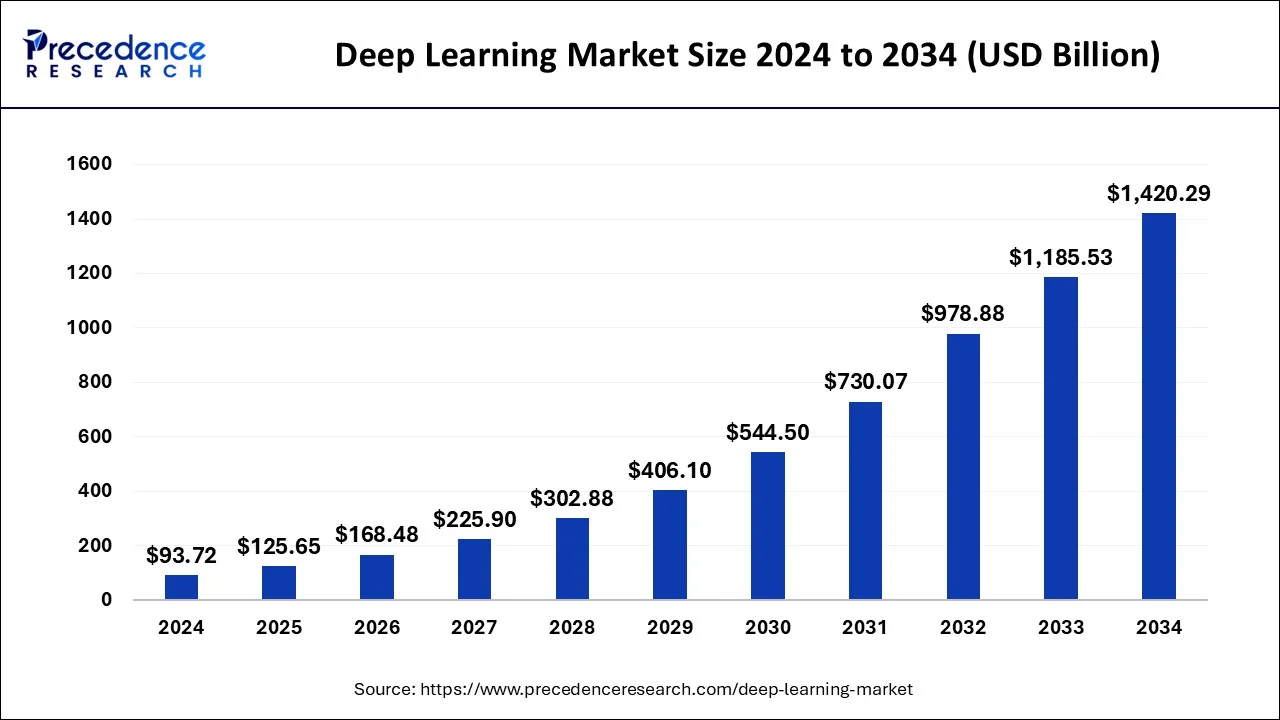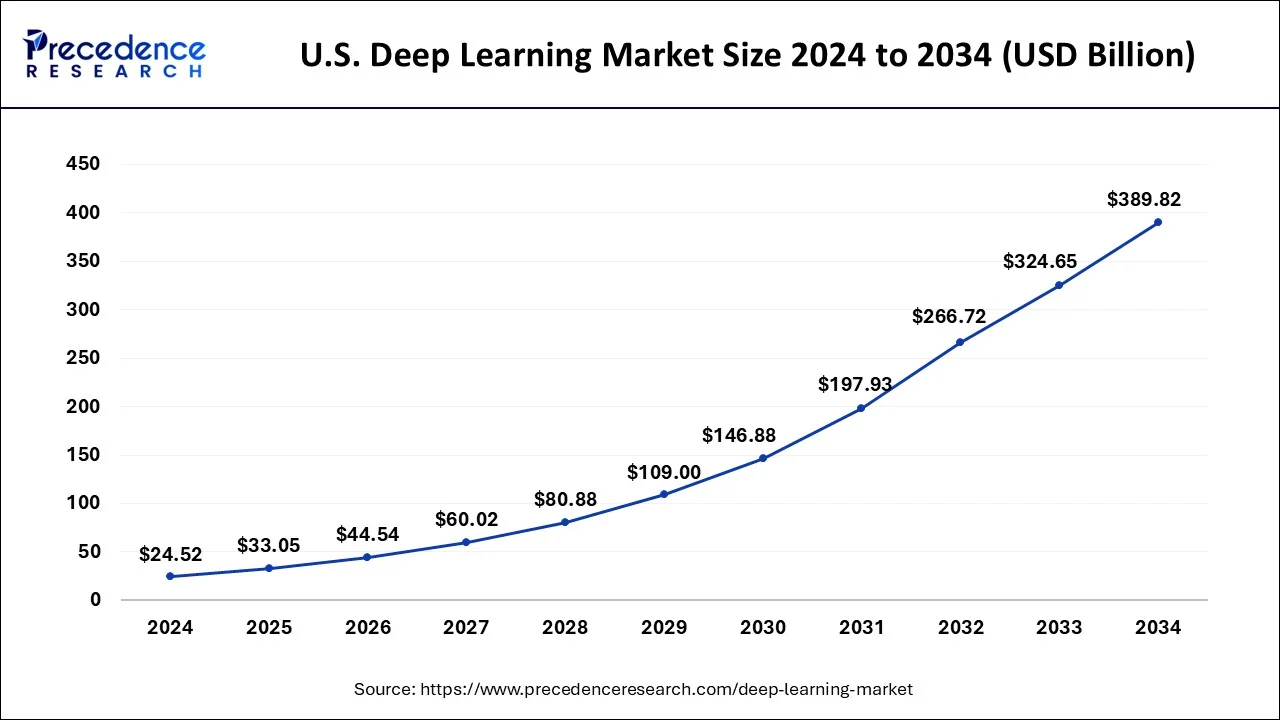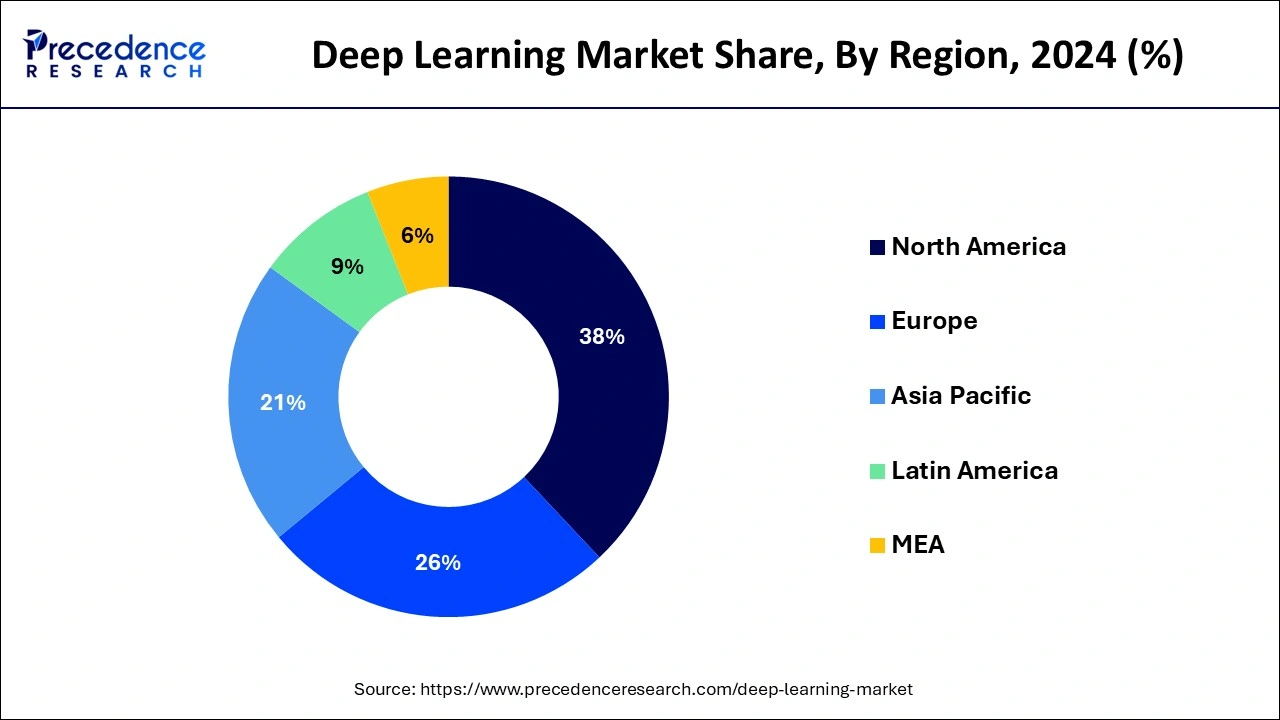List of Contents
Deep Learning Market Size and Growth 2025 to 2034
The global deep learning market size was estimated at USD 93.72 billion in 2024 and it is expected to hit around USD 1420.29 billion by 2034, expanding at a CAGR of 31.24% during the forecast period from 2025 to 2034.

Deep Learning Market Key Takeaways
- North America dominated the market with the highest market share of 38% in 2024.
- Asia Pacific is estimated to expand at the fastest CAGR during the forecast period.
- By type, the software segment is expected to sustain its dominance throughout the forecast period.
- By application, the image recognition segment is expected to witness significant growth during the forecast period.
- By end-user, the retail segment is expected to expand at a robust pace during the forecast period, the segment also held a significant share in 2024.
U.S.Deep Learning Market Size in 2025 to 2034
The U.S. deep learning market size was estimated at USD 24.52 billion in 2024 and is projected to surpass around USD 389.82 billion by 2034 at a CAGR of 31.87% from 2025 to 2034.

North America dominated the market with the highest revenue share of 38% in 2024, the region will continue to witness a significant increase in its market share during the forecast period. The growth of the region is attributed to the rising adaptability of the technologies in the region. The well-established healthcare infrastructure along with the willingness to adopt advanced technological solutions from the industry is observed to be likely to contribute to the growth of the deep learning market across the region. Digitization in almost every sector of the region promotes the market's growth.
For instance, digitization in the healthcare sector of North America has already started contributing to the pace of transaction-related and data management activities. Whereas the penetration of deep learning is observed to fuel the efficacy of digitized activities in the region in the upcoming years. Moreover, the automotive and retail sectors are expected to witness significant growth by the adoption of deep learning. Emerging economies such as Canada and United States are expected to contribute to the growth of the market.

Asia Pacific is expected to witness the fastest rate of growth during the forecast period. The growth of the region is expected to rise due to the increasing technological advancements in the countries such as India, China, and Japan. Rising investment in the technological sector including IT by the major key players globally will be anticipated to rise in the development of artificial intelligence and its branches. The emerging retail sector and other industries will create major demand for advanced solutions for data management and efficient workflow, these would be the major factor for the growth of the deep learning market across the region.
Market Overview
Being the most prominent segment of machine learning, deep learning is a part of neural networks of artificial intelligence. Deep learning is an advanced subset of multiple layers in the networks that are capable of working without any human intervention. Deep learning performs the task repeatedly and improves or enhances the outcomes, it can be used for automating predictive analytics to identify the trends and interests of consumers.
Deep learning algorithms are used by multiple industries for predictive analysis and decision-making processes. The global deep learning market is mainly observed to be accelerated by the booming e-commerce industry across the globe. Multiple e-commerce platforms, healthcare and other service providers have started participating actively in the adoption of deep learning technology owing to its capability of analyzing consumer's preferences, and history of buying and offering additional suggestions for products. With such advanced capabilities, the deep learning segment is expected to be the most attractive one in the overall artificial intelligence sector.
Deep Learning Market Growth Factors
Deep learning is another term that is under the artificial intelligence program. Deep learning algorithms are used by several industries due to their computational ability, data capabilities and performing tasks without human intervention. Higher technological advancement in several industries will contribute to the substantial demand for deep learning in multiple industries while supplementing the growth of the market. In recent times, multiple service provider industries have witnessed the development of several applications supported by deep learning that can be used on a day-to-day basis. Applications like virtual assistance or generative chatbots utilize deep learning algorithms to produce the desired results. The rapidly expanding generative AI solutions are also observed to highlight the growth of the deep learning market.
Deep learning can generate algorithms automatically without any human interference, it is used for the analysis of the enormous amount of data generated by industries. Deep learning is used to train the system for detecting the already existing characteristics on its own. Deep learning algorithms can be used by many industries such as chemicals, healthcare, ceramics, agriculture, etc. All industries carry a large amount of data to be analyzed. Deep learning is currently considered the most advanced data classifier and implementing technological advancement in industries to be sustained in the competitive market.
Market Scope
| Report Coverage | Details |
| Growth Rate from 2025 to 2034 | CAGR of 31.24% |
| Market Size in 2025 | USD 125.65 Billion |
| Market Size by 2034 | USD 1420.29 Billion |
| Largest Market | North America |
| Base Year | 2024 |
| Forecast Period | 2025 to 2034 |
| Segments Covered | By Type, By Application, and By End-user |
| Regions Covered | North America, Europe, Asia-Pacific, Latin America, and Middle East & Africa |
Market Dynamics
Driver
Increasing implementation by the healthcare sector
The healthcare sector has started utilizing deep learning to enhance diagnostic precision and offer personalized treatment regimens. The healthcare industry is also observed to implement deep learning algorithms to analyze medical imaging, such as MRI and CT scans, for the early diagnosis of diseases like cancer. A further illustration is the application of deep learning in drug discovery, where algorithms may analyze vast volumes of data to find potential brand-new medicines. Deep learning is also utilized in the banking sector to enhance risk management and fraud detection. Moreover, the management of data related to transactions at healthcare centers/hospitals can be done effectively with the help of deep learning solutions, thus all these factors aim to boost the adoption of deep learning solutions in the healthcare sector while fueling the growth of the market.
Restraint
Unavailability of large and reliable data
Big data is used as the training dataset for deep learning, which gives it an advantage. The unavailability of a sufficient amount of reliable data can be a drawback for the whole system. For a model to function successfully, substantial data is required. Due to the time and lack of available resources, collecting this data can be challenging. It is significant to highlight that compared to other machine learning models, training a specific model using huge datasets needs more processing power. The higher requirement of resources and time for the computation of data is one of the major market restraining factors.
Opportunity
Enormous demand from the manufacturing sector
As industrialization along with product requirements increases across the globe, the manufacturing sector is expected to be fueled. Multiple manufacturing processes require automated and advanced solutions/ systems to carry out repetitive tasks without any human intervention. Deep learning is being utilized in the manufacturing sector to increase the accuracy and efficiency of industrial processes. Using deep learning algorithms for predictive maintenance is one example of this, where machines can foretell the requirements of repairing or maintenance, minimizing downtime and boosting production of the manufacturing sector. Another illustration is the application of deep learning to quality control, where computers can inspect product photos and videos to make sure they adhere to predetermined criteria. The manufacturing industry is the most emerging sector which will become the future opportunity for the development of the deep learning market.
Type Insights
The software segment is estimated to dominate the global deep-learning market. The growth of the segment is attributed to the rising adoption of deep learning software into applications like chatbots, voice and image recognition, smartphones, ATMs, etc. Deep learning software enables the documentation classification algorithms task to involve assigning the documents, allowing it to easily manage the data. Deep learning algorithms can manage the data manually and the data may be in the form of images, texts, music, etc. Another software in deep learning involves image recognition which is useful in the security of gadgets. Deep learning software could be useful for enhancing the quality and working capabilities of the applications.
Application Insights
The image recognition segment is expected to generate significant revenue during the forecast period. The growth of the segment is attributed to the rising demand for recognition pattern, optical character recognition, code recognition, etc. The increasing use of image recognition systems in smartphones, and for security purposes will impact the demand for image recognition in the market positively. With the deep learning technology for image recognition systems organizations can automate data analytics for CCTV streamlining, clips, videos, and drone footage. Image and video recognition are used for security check-ins in airports, office premises, stations, etc. Multiple educational institutions and corporate firms are actively participating in the adoption of contactless and manual attendance. The deep learning solutions are observed to contribute for the same cause. Deep learning for image recognition aims to perform eKYC task for multiple online platforms that require payment activities. All these factors highlight the development of the segment.
End-user Insights
The retail segment held a significant share in 2024, the segment is expected to grow at a robust pace throughout the forecast period. The growth of the segment is attributed to the higher use of artificial intelligence and machine learning for forecasting customer demand. Deep learning is the subset of machine learning which is used for analyzing and predicting the needs and preferences of customers. Deep learning can assist the retailer with the latest trends in the market. Deep learning neural can identify and extract the requirements of the consumers by the customers' previous activities and offers the best results according to the need of the customers. Deep learning can be used for retail security where the risk of cyberattacks, or fraud is high.
Deep Learning Market Companies
- Facebook Inc.
- Google LLC
- Microsoft Corporation
- IBM Corporation
- Amazon Web Services Inc.
Recent Developments
- In July 2023, the new version of Behavioral Analytics was launched by Wavesys Global which introduced the latest WVCA behavior license with several new algorithms. The algorithm works on giving alert on motion or behavior like aggressive, fighter behavior, trip, and fall, slip, and fall, possession of hand-held objects, etc. with the work of a deep learning model.
- In July 2023, Intel recently launched Habana Gaudi 2, the launch is specifically for the Chinese Market, it is a specially designed accelerator card. It increases interference capabilities and AI training, delivering increased efficiency and performance in deep learning in China.
- In July 2023, Elon Musk the chief of Tesla launched its latest company xAI, which is based on the artificial intelligence sector. The basic nature of the company is to understand the nature of the universe.
- In July 2023, the startup behind a generative AI research platform for investment analysts “Portrait Analytics” raised a $10 million investment by Unusual Ventures. The organization's vision is to help analysts on reading research companies, increase the speed of investors can find and become experts on the organizations.
Segment Covered in the Report
By Type
- Software
- Hardware
- Services
By Application
- Image Recognition
- Signal Recognition
- Data Processing
By End-user
- Retail
- BFSI
- Manufacturing
- Healthcare
- Automotive
- Telecom and Media
By Geography
- North America
- Europe
- Asia-Pacific
- Latin America
- Middle East and Africa
For inquiries regarding discounts, bulk purchases, or customization requests, please contact us at sales@precedenceresearch.com
Frequently Asked Questions
Ask For Sample
No cookie-cutter, only authentic analysis – take the 1st step to become a Precedence Research client